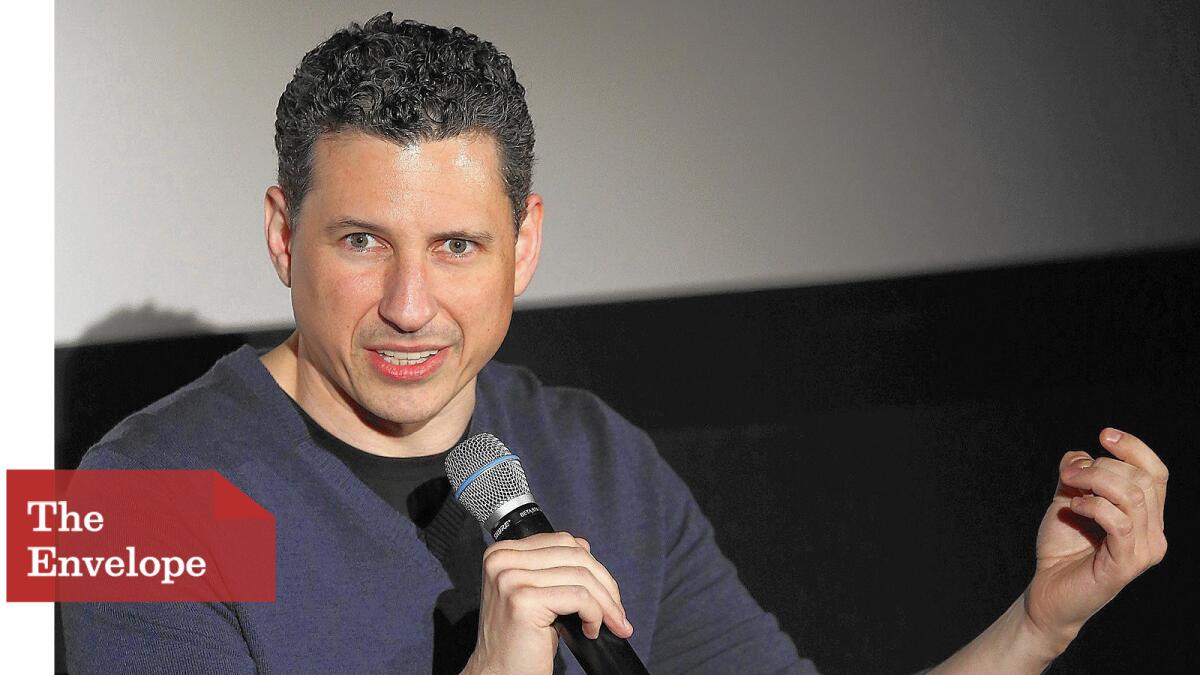For ‘Hateful Eight’s’ film editor, there’s nothing too outlandish to try

- Share via
Film editor Fred Raskin recalls the evening of April 19, 2014, when he and more than a thousand other guests witnessed something special: a live reading inside the Theatre at Ace Hotel in downtown Los Angeles. The production being presented? The script for Quentin Tarantino’s “The Hateful Eight,” which the director was staging live because it had already been leaked online and he refused to make the film as a result. “He was really heated about it,” actor Samuel L. Jackson told The Envelope. Thankfully, he cooled down and went on to make his violent, post-Civil War parlor drama, which opened on Friday.
The experience for Raskin on that spring night “was pretty unforgettable. The majority of the cast went on to do the film and Quentin inserted his personality and sense of humor into the proceedings as he read the stage directions. When the script made mention of black bounty hunters, Quentin would interject with “Ding-ding-ding, that’s a ‘Django Unchained’ reference!” He injected that same personality from the live read into the narration that introduces the second act of the movie.”
SIGN UP for the free Indie Focus movies newsletter >>
And just as Tarantino went on to make his film, Raskin too went on to make “The Hateful Eight” alongside him in the editing room.
Take us back to your first memory of Quentin Tarantino.
I was a fan from the moment I saw “Reservoir Dogs” in college. I went to NYU and I remember going to see it with three of my classmates. We came out saying it was easily the best movie of the year. When I ended up becoming an assistant on the “Kill Bill” films, I was thrilled. We did a lot of sound effects editing and having Quentin be pleased with the work we did was unreal. But being able to edit for him and see his reaction, it’s a total pinch-myself kind of job.
Your first non-assistant job with Tarantino was “Django Unchained.” How did you approach this edit?
Quentin doesn’t set foot in the editing room during production. He focuses entirely on shooting but we did screen dailies together in Telluride, Colo., where the location production took place. He would lean over and tell me something he liked or a particular performance he enjoyed. Since “Django” I’ve learned whenever he laughs at something in dailies, it’s something he really likes. We find ourselves laughing at the most inappropriate moments, like John Ruth [Kurt Russell] elbowing Daisy [Jennifer Jason Leigh] in the face. When shooting is over, Quentin is in the room all day. He puts everything into the writing and directing of his movies, so it’s no surprise that he’s equally dedicated all the way through the editing process.
Watching the film, you don’t feel like it’s three hours. Did the chapter breaks play into that?
I think so. There are six chapters and Chapter Five starts before Chapter One to provide back story for the characters so you know in the final chapter where all of the characters’ loyalties lie. There are also flashbacks and different perspectives we work in — like when Daisy sees who puts the poison inside the coffee pot — that give the audience something different. We had an early version of the cut where we eliminated the Chapter Two card, so the first chapter ran from the beginning of the movie all the way until they arrive at Minnie’s Haberdashery. The balance in that version felt off. Restoring that Chapter Two card gave us two shorter chapters and dramatically improved the pace.
With such a polished script and Tarantino’s vision, how did you look to interject your own influence?
One of the things I learned from editor Sally Menke was that Quentin gets thrilled by out-of-the-box ideas. The best example I can think of is from “Pulp Fiction,” when Uma Thurman’s character says “Don’t be a …” and draws a square on the screen. It’s a neat idea and what Sally pointed out that made it special was that it’s only done once in the movie. So when I’m putting together “The Hateful Eight,” I’m looking for things like that to do, be it an odd sound effects choice or a creative match cut between two different scenes. They might not necessarily stick, but I find that Quentin’s material really lends itself to us trying the most outlandish ideas.
What was it like working in that big 65mm Ultra-Panavision gloriousness?
For us, we were still cutting digitally on an Avid, but by regularly screening the dailies projected on film, we learned that we were able to stay on wide shots longer than you normally would — they were just beautiful compositions with tremendous image clarity. Every cast member had the screenplay committed to memory so Quentin was able to shoot very long takes when he wanted. The edit turned into the question of “Do we even want to cut to another angle? And if we do, we’d better have a damned good reason for doing it.” Another great thing we were able to do was every Wednesday afternoon we’d go over to the DGA building and watch [the cut footage] on the big screen. It was so beautiful — it really inspired us to do the best work we could do because everyone else had.
More to Read
From the Oscars to the Emmys.
Get the Envelope newsletter for exclusive awards season coverage, behind-the-scenes stories from the Envelope podcast and columnist Glenn Whipp’s must-read analysis.
You may occasionally receive promotional content from the Los Angeles Times.










